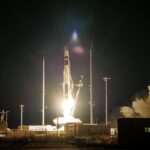
A U.S. Space Force official on May 2 said that the Space Based Radar (SBR) under development by the Space Force and National Reconnaissance Office (NRO) will be a proliferated low Earth (LEO) constellation. LEO has displaced geosynchronous as the orbit of choice for new DoD satellites, including those of the Space Force's Space Development Agency (SDA). SBR is to replace the retired Joint STARS aircraft by Northrop Grumman [NOC] for ground moving target indication (GMTI). SBR "allows us to…














